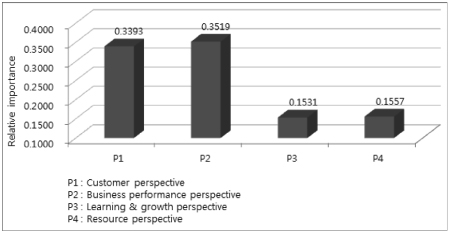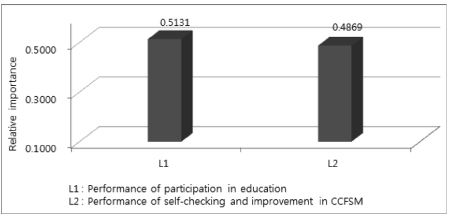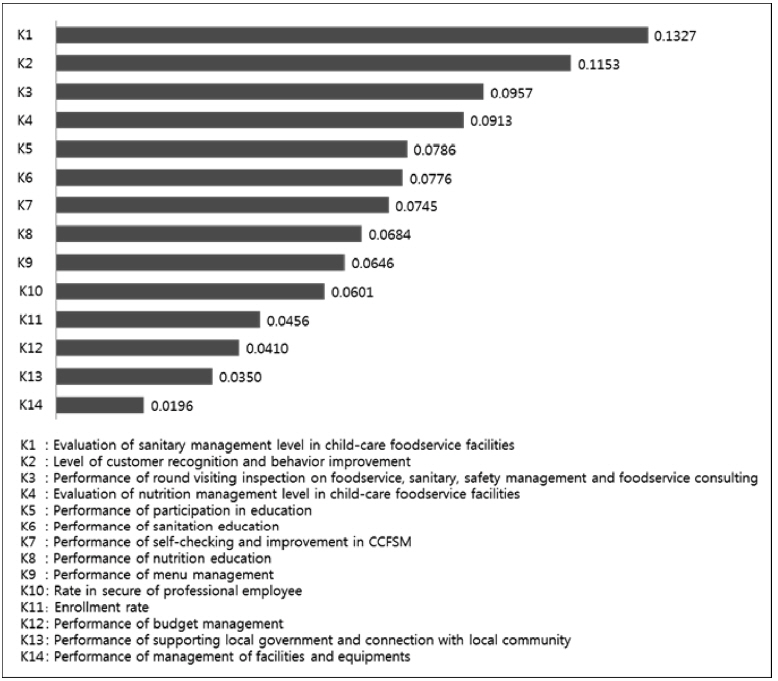References
1. Chang ML, Kim YB. A study of the actual conditions of kindergarten meals program. Korean J Early Child Educ 2003;23(3):261–284.
2. Staskel DM, Briley ME, Field LH, Barth SS. Microbial evaluation of foodservice surfaces in texas child-care centers. J Am Diet Assoc 2007;107(5):854–859.
3. Harker PT, Vargas LG. The theory of ratio scale estimation: Saaty\'s analytic hierarchy process. Manage Sci 1987;33(11):1383–1403.
4. Hwang DY, Kang KH, Gim KM, Baek MH. Development of woman farmers center performance indicators by using the analytic hierarchy process. J Agric Extension Community Dev 2008;15(4):599–619.
5. Jang YL. Development of sustainable eco-tourism evaluation models and indicators: Focusing on the specialist of eco-tourism by AHP analysis. Korean J Tourism Res 2012;27(2):455–475.
6. Jin JG. Government productivity: Conceptual framework and measures. In: Korean Institute of Public Administration KIPA Research Report. 1998. pp. 0-117.
7. Kaplan RS, Norton DP. The balanced scorecard-measures that drive performance. Harv Bus Rev 1992;70(1):71–79.
8. Kim DK, Park YW, Lee SM. Assessment of tourism resource development by the analytic hierarchy process: Focusing on the planning process. Korea J Tourism Hosp Res 2007;21(4):5–18.
9. Kim EH. A study on the development of performance evaluation model of the disabled welfare institutions using BSC and AHP. Korean Policy Sci Rev 2010;14(4):143–171.
10. Kim HK, Sung ES. In: BSC Practice Manual. Sigmainsight; 2004.
11. Kim HJ, Lim HG, Kim DG. The development on significancy and priority of KPI in contracted foodservice business in Korea using AHP. Korea J Tourism Hosp Res 2011;25(4):163–176.
12. Kim ST, Ahn SS, Lee HY. A study on the development of a CSR(Corporate Social Responsibility) evaluation model: with application of AHP(Analytic Hierarchy Process) technique. Acad Customer Satisf Manag 2011;13(1):169–187.
13. Kim SY, Yang IS, Yi BS, Baek SH, Shin SY, Lee HY. Childcare facility and kindergartens demands on foodservice support by center for child-care foodservice management (CCFSM) inSeoul and Gyeonggi-do. Korean J Community Nutr 2011;16(6):730–739.
14. Kim HK, Kim HJ. The development on significancy and priority of KPI in Korean coffee shop business using AHP. Korean J Hosp Adm 2012;21(5):195–205.
15. Kim JH, Kim WJ, Cho HK, Lee EY, Seo MW. A study on the development of evaluation model for selecting a standard for DITA using AHP. Ind Eng Interfaces 2012;25(1):96–105.
16. Ko YS, Yoon HS, Lee JH. In: Performance management in public service. Korea Development Institute; 2004.
17. Kwak TK, Lee HS, Yang IS. Assessment of food service management practices in day care centers. Korean J Soc Food Sci 1991;7(4):103–109.
18. Lee SG. Consolidated performance management for local governments with the introduction of performance-based budgeting system: With special reference to the case of Seoul metropolitan government. Korean J Local Finance 2003;8(1):135–162.
19. Lee BS. The survey on the foodservice management system of the child care centers in Ansan. Korean J Food Nutr 2006;19(4):435–447.
20. Lee MA, Yang IS, Yi BS, Kim HA, Park SH. Analytic hierarchy process approach to estimate weights of evaluation categories for school food service program in Korea. Korean J Nutr 2006;39(1):74–83.
21. Lee MS, Lee JY, Yoon SH. Assessment of foodservice management performance at child care centers. Korean J Community Nutr 2006;11(2):229–239.
22. Lee WS. Selection of indicator and establishment of system for a functional assessment of green space: Focused on forest green space. J Korea Soc Environ Restor Tech 2012;15(5):31–48.
23. Park JH. A study on civil administration service current and improvement method of central government. In: Korean Association for Public Administration Summer Consortium. 2000. pp. 553-568.
24. Park JH, Han HJ, L KJ, Park BS. Analysis and improvement in performance evaluation system and actual administration. In: KIPA Research Report. 2004. pp. 1-162.
25. Park S, Hong YW, Na JK. A method for selecting the evaluation index of defence R&D project by AHP. J Korean Data Inf Sci Soc 2012;23(5):961–970.
26. Park YM. A study on performance indicator of disabled welfare service. Jeonnam Assoc Public Adm 2001;8:413–431.
27. Saaty TL, Aczel J. Procedures for synthesizing ratio judgements. J Math Psychol 1983;27(1):93–102.
28. Saaty TL. In: Fundamental of decision making and prority theory with the analytic hierarchy process. Pittsburg: RWS Publications; 1994.
29. Saaty TL. In: Decision making for leader: the analytic hierarchy process for decisions in a complex world. Pittsburg: RWS Publications; 1999.
30. Sohn CY, Yang IS. A analysis of relative importance of evaluation categories for hospital food service by analytic hierarchy process. Korean J Food Nutr 2010;23(4):470–477.
31. Staskel DM, Briley ME, Field LH, Barth SS. Microbial evaluation of foodservice surfaces in texas child-care centers. J Am Diet Assoc 2007;107(5):854–859.
32. Um DH, Kim DS, Kim TC, Kim ES. A study on the Development of green-tourism performance indicators by using BSC on rural village. J Korean Soc Rural Plan 2006;12(3):43–55.
33. Wholey JS, Hatry HP. The case for performance monitoring. Public Adm Rev 1992;52(6):604–610.
34. Yoon SJ, Kim KS, Kang ES. Application strategies on the BSC model of public performance evaluation system. In: KIPA Research Report. 2005. pp. 1-149.










